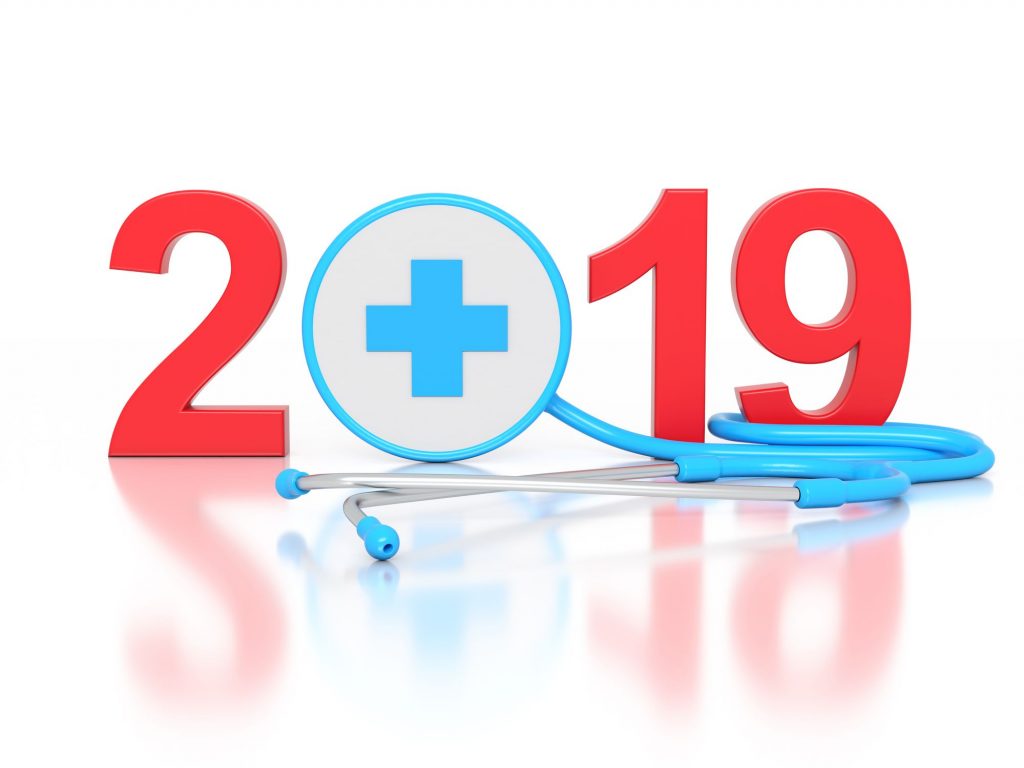As the final year of the “twenty-teens” approaches, health technology is making a bigger impact on patient care than ever before.
While development is still slower than other industries, healthcare’s future appears to be tied to technology and data as much as anything else in modern society. Over the last year, we’ve covered a number of these developments and how they effect the work and job prospects of professionals in the area of health informatics and healthcare analytics. But rather than looking back, let’s look forward to what 2019 has in store for the industry.
Here are some trends to keep an eye on:
Investment in AI Reaches New Heights
Forbes projects that the AI for health IT application market will exceed the $1.7 billion mark by the end of the year. This is primarily down to specialty specific analytics solutions and the growth of out-of-hospital technology solutions.
Machine learning is already becoming the norm in every day applications, but with consumers becoming more open to the idea of AI being involved in clinical decision-making processes and the FDA approving AI tools for risk scoring, clinical decision support systems and imaging diagnostics, it appears AI has officially arrived.
AI components are now being added to electronic health record platforms and health IT vendors are examining how AI can personalize experiences for patients, many of whom have come to expect technology to be more involved in their healthcare. But the most important development of AI in 2019 surrounds the death of the hype around it and the tackling of real-life challenges in clinical environments by its developers.
Big Data Gets Granular
As issues surrounding data management workflows are ironed out, the aforementioned specialty-specific analytics solutions will take off. More and more, the consensus is becoming that for big data to have any meaning or impact, it has to be digested by people whose actions can affect the trends the data is showing.
In 2019, greater focus is expected to be placed on getting the right information to the right people and in a way that they can digest it and make decisions informed by it. This goes for population health management efforts, identifying treatment pathways, determining clinical trial eligibility, billing discrepancies and measuring the success of self-care programs, to name a few.
While all of that data is useful for healthcare organizations to collect, it’s not meaningful or impactful if it’s not distributed in the right way to the right people. As AI fueled analytics platforms take off, look for it to have a significant effect on workflows and on the commonality of using data in the decision-making process.
Tech Community Gives Clinicians Voice
Doctor dissatisfaction with health tech has been a major issue in recent years. EHRs have been a notable pain point and as a result, many EHR companies will likely prioritize the physician experience in system design moving forward.
In doing so, voice interfaces are expected to be a useful tool in streamlining physician and nursing workflows. Google, Amazon and an increasing number of tech start ups are beginning to make strides in creating more robust voice technology platforms that can reduce typing, clicking around and using search functions for clinicians.
Amazon also has new tools aimed at mining clinical data that will help these functions work better. In the end, developing voice technology for healthcare may be easier than developing it for consumer applications due to smaller vocabularies and more consistency in terms of context.
Blockchain Goes Beyond Hype and Everyone Understands It!
While blockchain has been an incredibly popular buzzword and a favorite concept of professionals ranging from cybersecurity experts to patient empowerment advocates, it’s also been an overhyped idea that hasn’t been widely adopted or yielded the results some have expected.
That’s partially down to misconceptions about what blockchain will actually do. While it has been held up as a solution to the health IT industry’s interoperability woes, the truth is it can’t solve that issue until the industry settles on a standardized process and language, an issue plaguing current interoperability technology.
It’s been touted as unchangeable, but that is also not true according to Martha Bennett, who researches emerging technologies at Forrester Research as a principal analyst. She told Tech Target:
“You can rewrite history on a blockchain, and, most importantly, you sometimes need to. And we’re not talking about introducing a capability that we have with today’s database where you can overwrite or simply replace the record because that’s exactly what we’re trying to avoid. But you still get situations where the record that got on to the chain is quite simply wrong, and you need to do something in order to post a balancing transaction or something saying, ‘This is what it should be, not the previous one.'”
But in 2019, blockchain may just be set for its big moment as more people become familiar with what it can and can’t do. Payers and healthcare systems have begun adopting it and may well start performing transactions using it in the near future. The Synaptic Health Alliance is comprised of several major companies dedicated to using blockchain to share data in a way that can lead to administrative cost savings, improved demographic data and consumer experience. Companies involved include the project’s creator, Optum, as well as Humana, Quest Diagnostics, UnitedHealthcare, MultiPlan, Ascension and Aetna, which just merged with CVS Health.
The expectation when it comes to “administrative cost” is that blockchain has the potential to reduce the amount of manual labor, and thus the cost, associated with managing and reconciling data issues. It essentially eliminates the need for human intervention and redundant repair processes. And as for its flexibility when changes are needed to a transaction or say, an electronic health record, the creators of the alliance write in a whitepaper that:
“Transactions are recorded chronologically in a cooperative and tamper-resistant manner, and updates entered by any party on their record are replicated almost immediately across all the other parties’ copies. When updates to a transaction are entered and accepted, those updates amend, rather than alter, those transactions. All transactions and updates remain visible and unchanged, providing a real-time audit trail and ensuring data integrity.”
Healthcare Payers Buy into VBC, Reap Benefits of Vertical Integration
Insurance companies have already realized significant savings from value-based care initiatives. Now, thanks to increased vertical integration through mergers between major players in the industry, such as CVS Health’s acquisition of Aetna, information is flowing between providers, payers, pharmacy benefit managers and retail locations like never before.
In the case of Walmart, their attempts to buy Humana would give them a similar level of integration, while Cigna intends to buy Express Scripts to keep their offerings competitive in a market that is seeing data and integration prioritized.
The vertical integration trend is an effort to get out ahead of more major players entering the healthcare landscape, such as tech giants Amazon and Google. The impact those firms have remains to be seen, but one this is for certain. As data flows between bundled services and information collection practices become more standardized, payers will be moving the industry ever more steadily toward value-based care in an effort to operate more efficiently and profitably.
Digital Health Drives Healthcare Consumerism
There’s simply no doubting the healthcare consumerism movement. The reason tech giants and major retailers are so keen to get into the space is the scent of opportunity as healthcare embraces tech and data liquidity. Innovation is often driven by the prospect of profit and it’s no different here.
In the case of healthcare, it’s needed as consumer-focused initiatives can increase patient engagement and access to higher quality care. And in the eye of the consumer, it’s not so much an innovation any more as much as it is an expectation.
According to a survey done by Black Book, 93% of patients say they expect to use digital tools in facilitating interactions with their provider and when paying for services. At a time when the infrastructure of healthcare technology is blossoming to include key elements to innovation such as open APIs, data liquidity, interoperability and more refined analytics, 2019 has the potential to be a big year for technology that connects patients to healthcare services in a more a personalized way.
Some major areas of opportunity for patient engagement in health technology include social determinants of health (SDoH), connecting patients to their EHRs and creating fully interoperable frameworks between health information exchanges, such as the work being done in connecting Carequality and CommonWell, so that useful information is being exchanged between all parties to facilitate a more streamlined consumer experience.



